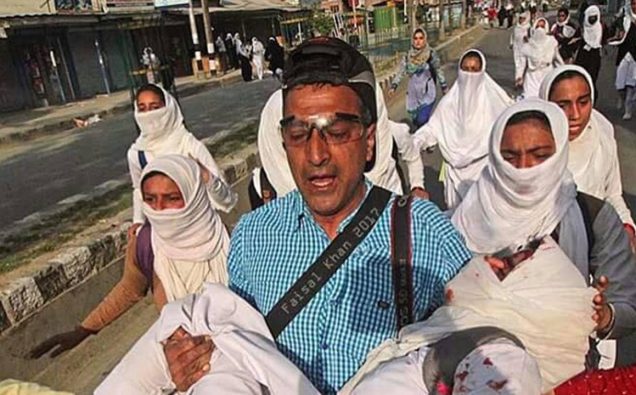
AP photographer Yasin Dar carrying injured Kashmiri girl to safety Photo courtesy Faisal Khan
It was another day of troubles in the Indian controlled Kashmir. But it was no ordinary moment for a workaholic photojournalist of Srinagar, who has been performing his professional duty witnessing and capturing some heartbreaking moments.
Yasin Dar had to take a decision in a split second – it is a conflict – students throwing stones and police using force including fire and shelling to quell them. Anything could happen to anybody. Last year a BBC journalist was blinded, and more than a dozen journalists have been wounded in the line of duty.
Whether he should continue covering the clash between the students and the Indian forces or save a young girl with her forehead bleeding from a rock hit was the question facing Dar. In a fraction of a second, the 43-year-old decided to save the life of a human being. He took the girl into his arms and ran to the car to take her to hospital.
Since then the photograph of Yasin Dar carrying the wounded girl to safety has gone viral on the social media, with thousands praising the humanity of a professional, and some calling him a symbol of hope.
With the world witnessing so many conflicts, photographers are often run a high risk of getting caught in the crossfire.
Many in Kashmir and other parts of the world are comparing Yasin with Syrian photographer Abd Alkader Habak, who was captured picking up a young boy in his arms and running to safety to escape bombing. Like Syrian photographer’s image while helping the victim, Yasin’s move won hearts of millions across the globe.
Yasin is a staff photographer with the Associated Press in Srinagar and has been covering the Kashmir conflict since 2002. According to media reports, that day, Khusboo, a college student was part of the students’s protest in Srinagar against the highhandedness of Indian security forces in a college situated in Pulwama district of Kashmir, when a stone hit her on the forehead like a missile.
With blood gushing from her forehead, Khushboo’s friends panicked, finding no one around to help.
It was in that split second that Yasin decided to set aside his duty as a media person, picked up Khushboo and ran to get her inro a car to the hospital. The image of Yasin running with Khushboo was captured by another Srinagar-based photojournalist Faisal Khan.
When a Srinagar-based senior journalist, Athar Parvaiz , tweeted the image, it immediately got attention of the people.
“These two images tell us why we should salute Kashmir’s @daryasin and Syria’s @AbdHabak , who put down their cameras and helped victims,” the twitter message read.
Yasin Dar who is a father of two daughters, told Khushboo’s friends that, she is just like his daughters. Khushboo was taken to a hospital in time and is now stable.
Dar’s act of kindness has evoked an interesting set of responses from several media persons and analysts to a situation involving professional work and human emotions in conflict situations of life and death.
The precarious situation puts journalists in a difficult situation, and could turn them into heroes of humanity at a great risk to their own lives. And if they choose to take pictures and leave a hapless soul at the mercy of any threatening forces, criticism could haunt him for life.
As The Hindustan Times reported in 1993, Kevin Carter, a photographer, captured the image of a malnourished toddler during the Sudan famine,, crawling towards some food, while a vulture waited nearby. “Though the image came to symbolize the suffering of the people in Sudan during the famine, helped raise funds for sufferers and won a Pulitzer, many expressed concern over the fate of the child and criticized Carter for not helping him. Some termed Carter “another predator,” the newspaper noted in a report.
The Kashmir conflict has been the underlying cause of tension between Pakistan and India for seven decades. An article in the New York Times recently wondered if the blinding of protesting Kashmiris in pellet gun fires is the largest mass blinding campaign in history.


















